HEALTH CARE
Pig Rearing
Nutrient Deficiency and Symptoms
| Vitamin A | Reduced weight gain, in-coordination, posterior paralysis, blindness, atrophy of epithelial layer of genital tract, reduced fertility, resorption of foetus. |
| Vitamin D | Rickets, osteomalacia, enlargement of joints, lameness, tetany, rib and vertebrae fracture. |
| Vitamin E-Selenium | Mulberry Heart Disease, Hepatosis dietetic (Liver necrosis), White muscle disease, degenerative thrombotic vessel injury. |
| Vitamin K | Newborn pigs with loss of blood from umbilical cord, Internal haemorrhage, sudden death. |
| Biotin | Excessive hair loss, skin ulceration and dermatitis, exudates around the eyes, transverse cracking of hooves, spasticity of hind legs, scaly skin |
| Choline | Lowered reproduction, spradled legs, rough hair coat, fatty infiltration of liver and kidney. |
| Folic acid | Slow weight gain, fading hair colour, bone marrow hyperplasia, anaemia. |
| Niacin | Necrotic lesion of intestine, Ulcerative gastritis, severe diarrhoea, rough hair coat, hair loss. |
| Pantothenic acid | Abnormal movement of the hind legs called “Goose stepping, Slow growth, diarrhoea, anorexia. |
| Riboflavin | Slow growth, seborrhoea, cataract, stiff gait, alopecia, poor conception. |
| Thiamine | Loss of appetite, reduced weight gain, sudden death, cardiac hypertrophy. |
| Pyridoxine | Reduced appetite and growth, exudates development around the eyes, convulsions, ataxia, epileptic seizures, coma and death, anaemia, fatty infiltration of liver. |
| Vitamin B12 | Reduced weight gain, loss of appetite, irritability, hypersensitivity, rough skin and hair coat, hind leg incoordination. |
| Vitamin C | Petechial haemorrhages throughout the body. |
| Calcium and phosphorus | Depressed growth and poor bone mineralization resulting in rickets in young pigs and osteomalcia in older swine, beading of nibs, lameness and tetany, posterior paralysis. |
| Sodium and chlorine | Deprived appetite, unthrifty condition. |
| Magnesium | Hyper irritability, Muscular twitching, reluctance to stand, weak pastern. Loss of equilibrium, stepping syndrome, tetany. |
| Potassium | Anorexia, rough hair coat, emaciation, Ataxia, cardiac impairment. |
| copper | Poor iron mobilisation, Abnormal haemopoisis, poor keratinization and synthesis of collagen, elastin and myelin, microcytic hypochromic anaemia, bowing of legs, spontaneous fracture, cardiac and vascular disorders. |
| Iodine | Stunted growth, lethargic, elongated thyroid, weak or dead piglets that are hair less, Myxedema. |
| Iron | Anaemia, poor growth, listlessness, rough hair coat, wrinkled skin, pale mucous membrane, laboured breathing with a spasmodic jerking of the diaphragmatic muscle called “Thumps”. Anemia, enlarged fatty liver, ascites. |
| Manganese | Abnormal skeletal growth, increased fat deposition, irregular or absent oestrus cycle, reabsorbed foetuses, small weak pigs at birth, reduced milk production. |
| Selenium | Sudden death is a prominent feature of selenium deficiency. Hepatosis dietetic, white muscle disease, mulberry heart disease. Impaired reproduction. Reduced milk production. Impaired immune response. |
| Zinc | Poor growth, poor appetite, Parakeratosis, retarded testicular development. |
Bacterial Diseases
| Diseases | Symptoms | Prevention and control |
| Brucellosis | Abortions, infertility in sows and gilts Orchitis in boar | No treatment, no safe and reliable vaccine. Depopulating the infected herd to eradicate the disease. |
| Leptospirosis | Inappetance, fever, diarrhea lasting for 1-3 days, abortion during last 3 weeks of expected gestation | Vaccination is recommended, the infected ones should be segregated. |
| Swine erysipelas | Temp: 40o-42oC, sudden deaths observed, Diamond-shaped skin lesions but may disappear after 4-7 days. Light pink to light purple lesions are indicative of a non-fatal, whereas grey, dark purplish and red lesions usually preceeds death. | Vaccination is recommended twice a year. |
| Atrophic rhinitis | First signs in pigs as young as 1 week old are sneezing and sniffing. They may subside in a few weeks time but when it persists for more than 3 weeks atrophy of turbinates usually occurs, this may result in distortion of snout to the right or left. | Even without treatment, the animal may get natural clearance. The recovery may not prevent the stock from acting as carriers of infection. |
| Salmonellosis | Restless and febrile (40.6o-41.7oC), diarrhea is seen on third to fourth day with watery yellow feces, mortality is high | |
| Pasteurellosis | Sudden onset, weakness, incoordinated gait, high temperature (105-106F), cough, dyspnea, anorexia and labored “thumpy abdominal breathing”. | Vaccination is recommended |
| Clostridial entiritis | Haemorrhagic diarrhea, sometimes reddish brown faeces, non-haemorrhagic diarrhea. Dies within few days. | Immunization is recommended along with good sanitation management. |
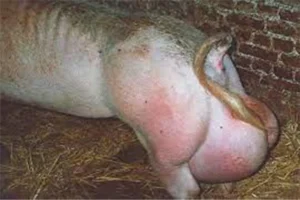 Orchitis- Brucella |  Aborted fetuses- leptospira |
 Misshaped turbinate- Atopic dermatitis | 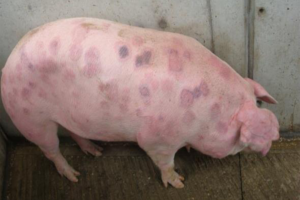 Diamond shaped skin lesions- Erysepelas |
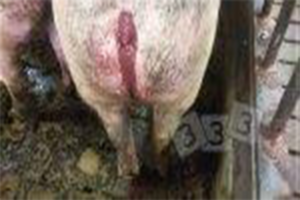 Bloody diarrhea- clostridium |  Yellowish diarrhea- salmonella |
Viral Diseases
| Foot and Mouth Disease | It manifests itself in the form of vesicles or erosions on the mucosa of mouth (tongue, lips, gums and pharynx palate) and feet with sharp rise in temperature by 5-6oC.
These vescicles ruptures leaving a raw, haemorrhagic and granular surface denuded of epithelium.
 |
There is no specific cure. Vaccination is recommended. To control, all the affected animals should be destroyed, burnt or buried along with the bedding material. |
| Swine Influenza | Sudden onset, cough, dyspnea, fever, prostration and rapid recovery. But reduced growth rate and feed consumption is observed. | No specific treatment. Good housing and nursing are important. No vaccine is available. |
| Hog cholera | Initially appears drowsy. On the sixth day temperature reaches 42.2oC. apathy, anorexia, blotchy, skin reddening, diarrhea, ataxia, convulsions and finally death | No effective treatment. Vaccination is recommended twice at 3 weeks age and again at 3 months |
| Transmissible gastroenteritis | Transient vomiting accompanied by watery usually yellow diarrhea, rapid loss of weight and high mortality in pigs under 2weeks of age. | Only treatment is to alleviate starvation, dehydration and acidosis. |
| Swine pox | Skin eruptions on the entire body, they progress from papular to pustular to a crustating stage. After healing small white discolored spots are seen.
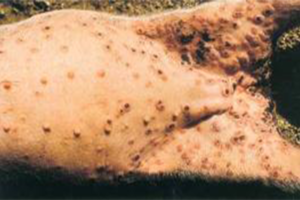 |
Improve sanitation, newly purchased pigs may be examined for lesions. |
| Aujesky’s disease/ psuedorabies | Sneezing, coughing, slight fever, excessive salivation, spontaneous muscle spasms and death after 4-9 days.
 |
Vaccination is recommended |
| African swine fever | Initially appears drowsy. On the sixth day temp reaches 42.2oC. apathy, anorexia, blotchy, skin reddening, diarrhea, ataxia, convulsions and finally death | Quarantine of affected animals, movement restriction, thorough disinfection of pens, houses, trucks, railway wagons. Vaccination is recommended |
External Parasitic Infestations
| Symptoms | Treatment and control | |
| Sarcoptes mange | Irritation and thickening of skin of the affected body parts, hypersensitivity, lesions resemble those of hyperkeratosis | Controlled by pressure spraying affected parts with either of the following: lindane melathion, polysulphides, toxaphene, trichloroform. Treating with ivermectin to infected sows of 8- 37 days post-partum completely eliminates the mites. |
| Demodectic mange | Red pin point areas around the eyes and snout, along underside of neck and abdomen and inside the thighs. | |
| Lice / flies / fleas / ticks | Causes irritation | Treatment: dry powder containing 5.00% runnel can be applied to entire surface or animal can be dipped or sprayed with a suspension of 0.25% melathione or 0.25% runnel or 0.6% Co-Ral |
Internal Parasites of Pigs
Ascariasis
 |
Coughing, severe infestation is manifested by unthriftiness, poor body weight gains and reduced efficiency of feed utilization. Liver damage is permanent. As such the performance of the pigs after infection will be poor. |
Trichinosis
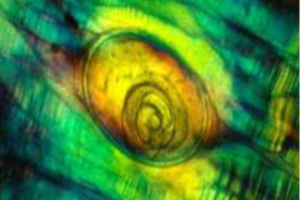 |
Vomitions, diarrhea, sweating and muscular rheumatic pains |
Whipworm / Trichuris suis
 |
Anorexia, mucoid diarrhea with blood in the feces, anaemia, labored respiration, emaciation, dehydration and death |
| Nodular worm / Strongylidae | Skin eruptions, local haemorrhages, acute diarrhea, emaciation, anaemia and vomiting |
Lung worm / Metastrongylus
 |
Cough and dispnea |
Kidney worm / Stephanurus dentatus
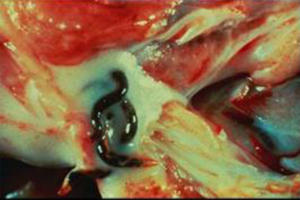 |
No clinical signs |
| Zoonotic Disease | R | Transmission | Clinical Signs in Swine | Clinical Signs in People |
| Etiologic Agent | Prevention for Swine | Prevention for People | ||
| Ascaris suum (Roundworms) | Ingestion: eggs in environment, on pigs, in manure, on fomites; contaminated plants, feed, water | Incubation period: 1-10 days Gastrointestinal: (young pigs) pendulous abdomen Respiratory: expiratory dyspnea (“thumps”); chronic paroxysmal cough Reproductive: delayed estrus, poor conception rates | Incubation period: 7-14 days Respiratory: cough, due to larva migration Gastrointestinal: diarrhea; vomiting; abdominal pain, intestinal obstruction in children | |
| Clean and disinfect; remove manure; deworm pigs; wash sows prior to putting in farrowing crate; wean pigs early (2-4 wks); all-in, all-out; rotate and till pastures | Wash hands; wear gloves; wash fruits, vegetables; don’t fertilize with pig manure; don’t let children play in contaminated soil; don’t drink untreated water | |||
| Brucellosis Brucella suis | A H | Direct contact: reproductive tissues/fluids Ingestion: contaminated feed, water Fomites | Incubation period: varies Reproductive: abortion, stillbirths; retained placenta; placentitis; orchitis; epididymitis Musculoskeletal: arthritis; lameness; spondylitis Cutaneous: abscesses | Incubation period: 2-4 weeks, up to 6 months Flu-like: headache; fever; fatigue; chills; aches Chronic: waxing, waning fever; bone, joint infections Reproductive: epididymo-orchitis; seminal vesiculitis and prostatitis; abortion or premature birth |
| Clean and disinfect; prevent exposure to wild and feral swine; obtain animals from Brucella-free sources; screening; isolate/cull infected animals; establish separate area for birthing; remove, destroy aborted fetuses, placentas | Wash hands; wear PPE (gloves, mask, eye protection, coveralls); cover wounds; don’t touch your face; handle infected animal tissues with gloves | |||
| Campylobacteriosis Campylobacter jejuni, C. coli | H | Ingestion: feces; reproductive tissues; contaminated soil, water Direct contact: infected animals Fomites | Incubation period: 3-25 days Asymptomatic in most Gastrointestinal: enteritis, diarrhea | Incubation period: 1-10 days Gastrointestinal: mild to severe GI distress; fulminant or relapsing colitis; fever; headache; muscle pain; children/vulnerable people most at risk for diarrhea |
| Clean and disinfect (including AI equipment); remove manure; prevent overcrowding; vaccinate (animals may still be carriers); isolate aborting animals; remove, destroy aborted fetuses, placentas | Wash hands; wear gloves; control rodents; keep children/vulnerable people away from animals or feces; avoid consuming undercooked meat, raw dairy, untreated water; wash fruits and vegetables; disinfect kitchen surfaces | |||
| Colibacillosis Escherichia coli STEC-Shiga-toxin producing E. coli VTEC-Verotoxin-producing E.coli EHEC-Enterohemorrhagic E. coli | H | Ingestion: contaminated soil, food, water Direct contact: feces Fomites | Incubation period: varies Gastrointestinal: (piglets) diarrhea | Incubation period: 1-16 days with most signs in 3-4 days Gastrointestinal: watery diarrhea; hemorrhagic colitis; nausea; vomiting; abdominal pain; cramping Systemic: hemolytic uremic syndrome (HUS); fever |
| Clean and disinfect; remove manure; vaccinate pregnant animals to reduce shedding; provide colostrum; minimize stress at weaning/diet changes; prevent crowding; all-in, all- out | Wash hands; wear gloves; keep boots outside the home; launder dirty clothing separately; prevent manure from leaching into groundwater; don’t consume raw dairy; cook meat thoroughly, especially ground beef; don’t cross- contaminate; isolate infected people | |||
| Cryptosporidiosis Cryptosporidium spp | H | Ingestion: oocyst- contaminated food, water, soil Fomites | Incubation period: 3-5 days Asymptomatic Gastrointestinal: (neonatal calves, lambs, kids, piglets) watery diarrhea; tenesmus; anorexia; weight loss | Incubation period: 2-3 days to 2 weeks Gastrointestinal: mild to severe profuse, watery diarrhea; abdominal cramps; anorexia; nausea; gas; malaise |
| Clean and disinfect (organism is resistant); remove manure; prevent overcrowding; provide colostrum; isolate sick animals; prevent/treat other infections | Wash hands; wear PPE (gloves, coveralls); don’t drink untreated water; wash fruits, vegetables; don’t cross- contaminate; avoid young, sick animals if vulnerable | |||
| Cysticercosis/ Taeniasis Taenia spp. | A | Ingestion: gravid proglottids in pastures; contaminated food, water or soil | Incubation period: months to years Asymptomatic Gastrointestinal: unthrifty; poor appetite; diarrhea Neurologic: neurological signs Ocular: eyelid nodules; visual impairment | Incubation period: variable; 8 weeks to years Gastrointestinal: proglottids in stools; nausea; gas; diarrhea; constipation; abdominal pain; poor appetite Neurologic: (neurocysticercosis) seizures; increased intracranial pressure; headaches; blindness |
| Clean and disinfect; remove manure; deworm farm dogs and cats; remove and destroy dead stock; do not use river water for animals; keep animals away from human feces | Wash hands; do not defecate in fields, pastures, waterways; treat infected people; don’t eat raw or undercooked meat; cook meat to proper internal temperature | |||
| Dermatophytosis/ Ringworm Microsporum spp., Trichophyton spp. | Direct contact: infected animals; skin lesions Fomites | Incubation period: 2-4 weeks Cutaneous: alopecia, scaling, crusts, erythema | Incubation period: 1-2 weeks Cutaneous: pink to red, scaly, slightly elevated skin lesions; follicular papules, pustules, or vesicles at the borders | |
| Clean and disinfect, specially shared equipment; quarantine and test new animals; isolate and treat affected animals; prevent exposure to rodents; do not overcrowd | Wash hands; wear PPE (gloves, coveralls); clean, disinfect equipment; treat infected animals; treat infected people | |||
| Erysipelas Erysipelothrix rhusiopathiae Erysipeloid in people | Direct contact: animals, fluids Ingestion: contaminated soil, feed, water; cannibalism (poultry) Mechanical vectors: biting insects | Incubation period: 1-7 days Acute: fever; prostration; red-purple spots on ears, skin; dyspnea; death Subacute: red-purple diamond-shaped skin lesions Chronic: joint swelling, lameness, dyspnea; death | Incubation period: 1-7 days Cutaneous: acute localized cellulitis; painful red/purple firm swelling, usually on hands and fingers; generalized disease possible | |
| Clean and disinfect; remove manure; control rodents; vaccinate (pigs, turkeys); cull symptomatic pigs; destroy infected carcasses | Wash hands; wear gloves; cover wounds | |||
| Giardiasis Giardia duodenalis or G. intestinalis | H | Ingestion: cysts in contaminated food, water, soil Direct contact: infected animals; grooming (self or others) | Incubation period: 3-10 days Asymptomatic, young more affected Gastrointestinal: (cattle, sheep, goats, swine) pasty to fluid, mucoid diarrhea; weight loss or failure to gain | Incubation period: 1-45 days; signs usually within 1-2 weeks Gastrointestinal: mild-severe, acute-chronic diarrhea Systemic: anemia; anorexia; weight loss |
| Clean and disinfect; remove manure; change bedding frequently; do not overcrowd; provide colostrum; do not use surface water as your water source | Wash hands; wear gloves; don’t drink untreated water (treat or filter fresh water prior to drinking); treat infected animals; prevent contact with feces; | |||
| Japanese encephalitis Flavivirus | A H | Vectors: Culex mosquitoes Reproductive: semen; transplacental possible | Asymptomatic Reproductive: Most common in naïve pigs; birth of stillborn or mummified fetuses; abortions; orchitis; infertility Neurologic (piglets): weakness; tremors; convulsions; death shortly after birth | Incubation period: 5-15 days Asymptomatic – Childhood disease in endemic areas (Asia, Western Pacific) Flu-like illness: fever; chills; myalgia; severe headache Neurologic: confusion; behavior changes; loss of consciousness; coma; difficulty moving; hemiplegia; quadriplegia; cerebellar disorders; neck pain and stiffness; mild to severe convulsions; transient Parkinson’s like signs; severe encephalitis (esp. children under 15 yrs. of age); neurological deficits in half of survivors Gastrointestinal: (children) nausea; vomiting; abdominal pain; +/- diarrhea Reproductive: miscarriage if infected in first pregnancy |
| Clean and disinfect; vector control; vaccines in endemic areas (Asia; Western Pacific); house animals in screened facilities; keep screens in good repair; minimize exposure to wild birds | Vaccination (endemic areas); prevent mosquito bites (insect repellants; protective clothing; permethrin-treated clothing and gear; bed nets); keep window screens in good repair | |||
| Leptospirosis Leptospira spp. – Sheep can serve as maintenance hosts of Hardjo serovar Weil’s disease in humans | H | Direct contact: infected urine; contaminated water; aborted tissues Ingestion: contaminated feed, water Inhalation: aerosolized urine, water | Incubation period: 7-12 days Reproductive: abortion; decreased fertility; stillbirth; weak offspring Systemic: (piglets) fever; icterus; anemia; death; Neurologic: (piglets) meningitis | Incubation period: 7-12 days Acute/septicemic phase: fever, chills, conjunctival suffusion, headache; myalgia; nausea; vomiting Immune phase: anicteric (common) or icteric forms; aseptic meningitis; stiff neck; headache; kidney failure; pulmonary hemorrhage; edema; dyspnea; death |
| Clean and disinfect, especially breeding/birthing areas; vaccinate; control rodents; prevent contact with reservoirs; provide safe, clean water for drinking; avoid contaminated water sources/ flood waters; quarantine and test new animals; prevent contact between cattle and swine | Wash hands; wear PPE (gloves, mask, eye protection, coveralls); cover wounds; control rodents; avoid wildlife; avoid contaminated water (like floodwaters); drain standing water if possible | |||
| Mange/Acariasis Sarcoptes scabiei var suis Scabies | Direct contact: infested animals Fomites: contaminated bedding | Incubation period: 10-60 days Cutaneous: rough, scaly skin; pruritus; alopecia; crusted skin | Incubation period: <24 hours to 4 days Cutaneous: severe pruritus on arms, chest, abdomen, thighs | |
| Clean and disinfect; power spray mite hiding places; quarantine and treat new or affected animals; prevent exposure to rodents and wild birds | Wash hands; wear gloves; treat infested animals; remove wild bird nests from buildings; keep bird housing areas clean | |||
| Staphylococcosis including methicillin-resistant Staphylococcus aureus (MRSA) | Direct contact: skin wounds; feces Fomites Inhalation: aerosols (dust) | Incubation period: variable Cutaneous: wound infections, abscesses Reproductive: mastitis; metritis | Incubation period: variable; 4-10 days Cutaneous: skin, soft tissue infection; necrotizing fasciitis; staphylococcal scalded skin syndrome Gastrointestinal: acute gastroenteritis (food poisoning); nausea; vomiting; diarrhea; abdominal pain; +/- fever; headache; blood, mucous in vomit, stool | |
| Clean and disinfect; remove manure; do not overcrowd; isolate infected animals; isolate infected animals | Wash hands; wear PPE (gloves, mask); cover wounds; avoid touching animal wounds, secretions; do not share personal items (towels) | |||
| Rabies Lyssavirus | AH | Direct contact: infected animal saliva (bite, droplet on mucous membrane, aerosol, broken skin) | Incubation period: 10 days to 6 months Paralytic: progressive paralysis; dysphagia; hypersalivation; ataxia; ascending paralysis; death in 2-6 days Furious: tremors; restlessness; aggression; ascending paralysis; death in 4-8 days; violent excitatory phase | Incubation period: a few days to several years, most commonly 1-3 mos. Neurologic: headache; fever; pain at inoculation site; anxiety; confusion; agitation, inability to swallow; hydrophobia; generalized paralysis; death |
| Clean and disinfect; vaccinate (including dogs and cats); isolate, euthanize, test symptomatic animals; prevent access to wildlife | Wash hands; wear PPE around exposed animals (gloves, eye protection, coveralls); avoid saliva; get rabies vaccine if high- risk; cover wounds | |||
| Salmonellosis Salmonella spp. ser. Typhimurium ser. Enteritidis (humans) | H | Ingestion: contaminated feed, water Direct contact: infected animal, feces Fomites Reproductive: vertical (poultry) Mechanical vectors: flies | Incubation period: varies; less than 1-2 days if severe Gastrointestinal: severe enteritis +/- blood; young most affected Reproductive: abortion Systemic: septicemia; CNS signs; (piglets) pneumonia | Incubation period: 6-72 hours Gastrointestinal: acute diarrhea (+/- blood); abdominal pain; nausea; vomiting; dehydration Flu-like: fever; muscle pain; headache; malaise; chills Systemic: (immunocompromised most at risk) bacteremia; septicemia (especially ser. Choleraesuis) |
| Clean and disinfect, especially equipment, buildings; remove manure; practice good biosecurity; control vectors; reduce stress; prevent overcrowding; quarantine new animals; isolate and treat, or cull carriers; all-in, all-out | Wash hands; wear gloves; wash and/or peel fruits and vegetables; cook meat to proper internal temperature; do not drink untreated water | |||
| Streptococcosis Streptococcus suis | Direct contact: infected animals Inhalation: aerosols Fomites Ingestion: contaminated feed, water Mechanical vectors: flies (S. suis) | Incubation period: varies; toxic shock within hours Reproductive: mastitis, metritis, placentitis, abortion Respiratory: purulent lung lesions; pneumonia Musculoskeletal: polyarthritis Neurologic: meningitis, ataxia, high mortality Systemic: septicemia | Incubation period: hours to 3 days Flu-like: chills; fever; malaise; upper respiratory disease Gastrointestinal: nausea; vomiting; abdominal pain Systemic: septicemia; endocarditis; glomerulonephritis; meningitis (especially S. suis); septic shock | |
| Clean and disinfect; remove manure; control flies; minimize stress; keep wounds clean; practice good animal husbandry; use good hygiene when milking (dip teats, keep milking machines clean, wear gloves); keep hair around udder short | Wash hands; wear PPE (gloves, coveralls) when handling animals; clean, cover wounds; don’t consume raw dairy | |||
| Swine influenza Influenzavirus A Most common: H1N1, H3N2 variant H1N2 | AH | Direct contact: nasal discharge Fomites Inhalation: droplets and aerosols from coughing/sneezing | Respiratory: fever; anorexia; dry cough; labored breathing; nasal discharge; conjunctivitis Reproductive: abortion | Respiratory: fever; chills; myalgia; upper respiratory symptoms; sore throat; lethargy; headache Gastrointestinal: (especially children) poor appetite; nausea; vomiting; diarrhea |
| Clean and disinfect; practice good biosecurity; provide good ventilation; minimize stress; prevent exposure to wild birds; all-in, all-out; vaccinate pigs (may not prevent infection and shedding); quarantine, test new animals; isolate infected animals; cull depending on virus strain; destroy infected carcasses; keep sick people away from animals | Wash hands; wear PPE (gloves, mask or respirator, coveralls); don’t touch your face; get the flu vaccine every year; avoid sick animals, wild birds; do not eat or drink around animals; cook meat and eggs properly; do not cross-contaminate | |||
| Toxoplasmosis Toxoplasma gondii | H | Ingestion: soil, plants, water, or feed contaminated with cat feces Reproductive: vertical | Incubation period: not known Reproductive: congenital infection; abortion; stillbirth; mummification Neurologic: encephalitis Respiratory: pneumonia; cough; dyspnea | Incubation period: 5-23 days Flu-like: fever; malaise; myalgia; lymphadenopathy Ocular: chorioretinitis; vitreous inflammation Reproductive: abortion; stillbirth (1st trimester) Congenital: chorioretinitis; hydrocephaly; encephalitis; visual and learning disabilities later in life |
| Clean and disinfect; keep cats out of animal areas; do not let cats prey on rodents or birds; remove and destroy aborted fetuses, placenta; swine housed outdoors more at-risk | Wash hands; wear gloves; do not clean if pregnant; cook meat properly; wash and peel fruits and vegetables; do not drink untreated water | |||
| Trichinellosis/Trichinosis Trichinella spp. (Parasitic nematode/ roundworm) | AH | Ingestion: raw or undercooked meat (pork, wild boar, wild game meat, horse meat) containing encysted larvae Reservoirs: rodents; wildlife (bears, game animals) | Asymptomatic: detected during meat inspection | Incubation period: 8-15 days Asymptomatic Gastrointestinal: nausea; vomiting; diarrhea; pain Flu-like: fever; myalgia; fatigue; weakness; headache; chills; cough; joint pain |
| Do not feed meat scraps or uncooked meat to pigs; remove animal carcasses to prevent ingestion and scavenging by swine; raise swine indoors; minimize exposure to wildlife | Wash hands; cook meat properly; freeze pork <6 in. thick for 20 days at 5°F to kill parasites; curing, smoking may not kill larvae; clean processing equipment after use; inspect home raised meat prior to eating | |||
| Trichuris suis (Whipworms) | Ingestion: egg- contaminated soil, feed, water; (people) Ingestion: contaminated food, water, soil | Incubation period: 2-3 weeks Gastrointestinal: diarrhea; weight loss; anemia; death may occur in piglets < 3 mos. | Gastrointestinal: diarrhea; vomiting; abdominal pain; intestinal obstruction, anemia, slow growth in children with high worm burdens | |
| Clean and disinfect; remove manure; deworm; keep on concrete/slats or dry pasture; rotate pastures | Wash hands; wear gloves; wash fruits, vegetables; do not fertilize with pig manure; do not let children play in contaminated soil; do not drink untreated water | |||
| Vesicular stomatitis Vesiculovirus | A | Direct contact: skin lesions, vesicles; saliva, nasal secretions Fomites Vectors: black flies, sand flies, others? | Incubation period: 3-7 days Asymptomatic Cutaneous: fever; papules, vesicles in/on oral cavity, udder, teats, prepuce, interdigital space, coronary band; inflammation; edema; pain Musculoskeletal: lameness | Incubation period: 1-6 days Flu-like: fever; headache; myalgia; malaise Cutaneous: (rare) vesicles Gastrointestinal: nausea; vomiting; diarrhea |
| Clean and disinfect, including milking equipment; milk animals with lesions last; minimize stress; control vectors; quarantine new animals; isolate infected animals; avoid hard, abrasive feeds to prevent mucosal injury; rule out foot-and- mouth disease | Wash hands; wear PPE (gloves, coveralls); clean and cover wounds | |||
| Yersiniosis Yersinia enterocolitica | Ingestion: fecal-oral; undercooked or raw pork, chitterlings/chitlins can be higher risk; fecal contamination of drinking water Direct contact: infected animals; animal feces | Asymptomatic Gastrointestinal: diarrhea in weaned pigs; mild fever; poor appetite | Incubation period: 4-7 days Gastrointestinal: acute diarrhea; nausea; vomiting; fever; abdominal pain; (young children) pseudoappendicitis; pharyngitis; mesenteric adenitis; (children) bloody diarrhea Musculoskeletal: reactive arthritis Cutaneous: rash “erythema nodosum”, more common in women Systemic: (infants, immunocompromised) septicemia; myocarditis |
